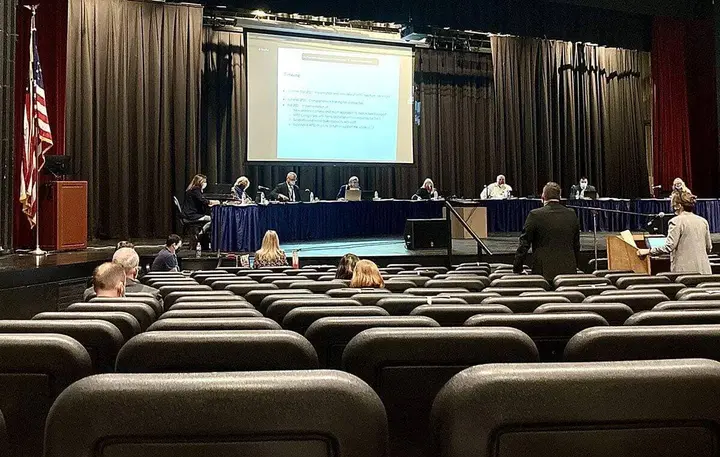Mathematics Student of the Month acknowledged at BOE meeting; board adopts Response to Intervention Program

The October 7 Board of Education meeting, the first to follow a new format previously established by the board, began with a reflection carried out by Trustee Victoria Buscareno in which both members of the board and the audience were asked to close their eyes and reflect on how they were feeling right there, in the moment. While the meeting had to be extended past 10:30pm, it relegated the discourse to the issues only, and was comparably tamer than meetings past.
The meeting adjourned with a student recognition made by Ms. Robin Rann, District Chairperson of Mathematics, as she introduced Northport High School senior Michael Torres as Mathematics Department Student of the Month. In a presentation created by the mathematics department, Ms. Rann described Michael as “very gifted and insightful, but at the same time very unassuming.”
Ms. Kristin Rozell, one of Michael’s math teachers at Northport High School, described him as “the perfect choice for this award… He loves learning math; he goes out on his own and researches math over the summer and in his free time.”
Michael is heavily involved in various technology courses, including the Academy of Information Technology, or AOIT. AOIT is an interdisciplinary program offered at Northport High School which prepares students for a career “in the areas of computer science, video editing, web design, programming, computer networking, and computer security and forensics.” During this extensive, four-year program, “students can participate in job shadow days, attend field trips touring the industry, listen to experts in the field, and participate in a paid summer internship.”
Mr. Patrick Winter, an AOIT teacher at Northport, stated that Michael is “the most creative and gifted programmer” he has gotten to work with.
Michael attributes his interest and curiosity in mathematics to his time in Mr. Glenn Buscareno’s fifth grade class in Ocean Avenue Elementary School. He hopes to go into mathematical research, with the Massachusetts Institute of Technology being his top choice of colleges.
After a photo opportunity with Michael, the board then heard a presentation regarding the Response to Intervention (RTI) program, of which they approved; the presentation was given by Tara Gaiss (District Coordinator of Reading and AIS), Lou Bonadonna (Assistant Superintendent of Special Education and Student Support Services), and Dana Boshnack (Assistant. Superintendent of Teaching and Learning).
The RTI program defines itself as a “structured, multi-tiered approach to help identify and support a struggling student” providing them with “systematically applied strategies and targeted instruction.” The program in question is specifically directed at those students in kindergarten through fourth grade struggling in either ELA or Mathematics. These specific grades were chosen because, as was acknowledged, the comprehension levels of an elementary school student increase dramatically from year to year as they progress through the grade levels. The program seeks to help those students – learning disability or not – who may be struggling.
From January to the summer of 2021, an RTI committee made up of 25 “general and special education teachers, instructional coordinators, teaching assistants, and building and district administrators” met and discussed the program. Working in collaboration with the committee was consultant Jim Wright, an author and lecturer on such topics as Response to Intervention and Multi-Tiered Systems of Support.
The adoption of a Multi-Tiered System of Support splits the RTI program into three levels. Tier 1 provides the child with classroom support to “get through the next lesson” and may culminate once the child shows improvement. Tier 3, on the opposite end of the spectrum, creates “an individualized intervention plan for intensive-need students.” Tier 2 aims to “find and fix off-grade-level skill gaps.” Quite simply, Tier 2 lies in the middle ground between lesson-to-lesson help and extensive, personalized intervention.
An emphatic point was made that students are not continuously flowing through each individual tier; once a student shows improvement, that student will be referred out of the program. If a student’s comprehension levels worsen, however, he/she may move through the tiers until recommended for consideration by the Committee on Special Education (CSE).
A full and extensive list of specific implementations and language can be foundhere, in the program’s memorandum.
Don’t miss a story
Get the latest news delivered to your inbox.








